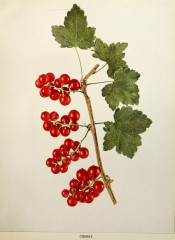Ribes rubrum ‘Cherry’
‘Bunches, short, with few berries. Berries, very large, of a deep red colour, and acid flavour, more so than the Red Dutch. It is the largest Red Currant. The bush is of a dwarf habit, with strong, short, and stout stunted-looking shoots; and it has the objectionable practice of sending up a gross shoot from the bottom, which almost invariably breaks off with the wind. The foliage is large, of thick substance, and dark green. The fruit ripens rather early.’ [Hogg – Fruit Manual p.318/1884]. See also Ribes rubrum L.
Horticultural & Botanical History
‘Perhaps this is the most popular currant for home and market use in America. It is esteemed for its large bunches and berries, and its vigorous, healthy plants. Cherry is generally considered the most productive of the large-fruited red currants. The berries, as the color plate shows, are beautiful bright red, of largest size, which, however, is not always uniform. The fruits are juicy and of excellent quality, from which the large seeds detract a little. In many localities the plants do not sucker freely, so that the bushes sometimes have too few stalks. There is, also, a tendency in the canes to “go blind,” that is, to lack the terminal shoot. Harvesting is made a little difficult by the short-stemmed bunches, the berries of which are so close to the wood that the crop is hard to pick. The plants are so vigorous and so luxuriant in foliage that they might well be planted as ornamentals. This variety seems to have originated in Italy and was introduced into France about 1840, and because of the extraordinary size of the fruit was named Cherry. It was introduced into Flushing, New York, by Dr. William W. Valk in 1846. Cherry was added to the recommended fruit list of the American Pomological Society in 1862.’ [The Small Fruits of North America p.284].
Card provides more detail on its early history. ‘Obtained from Italy by M. Adrienne Seneclause, a distinguished horticulturist of France. He received it among a lot of other currants known there under the name Ribes acerifolium. He gave it the name owing to the size of the fruit. It was fruited at the Museum of Natural History in 1843, and from the plants there grown was figured in the “Annales de Flore et de Pomone” for Feb. 1844. (Roe says 1848.)’ [Card – Bush Fruits p.305/1920].
‘Cherry Currant’ is figured with three other varieties as a frontispiece in The Horticulturist and Journal of Rural Art and Rural Taste [NS vol.4/1854]. A coloured figure is given in The Small Fruits of North America [The Small Fruits of North America p.284]. This is the illustration used here. It is interesting to see that this old variety was still esteemed in the USA in 1925. It was still popular in Australia near the end of the 19th century.
‘A robust, hardy variety, bearing short, thick bunches, and ripening earlier than most other kinds. Berries very large, deep red in colour, and rather acid in flavour. An excellent and prolific market variety.’ [Crichton - The Australasian Fruit Culturist vol.1, p.289/1893].
History at Camden Park
Listed only in an Addendum to the 1857 catalogue as ‘Cerite’ [Currant no.2/1857]. I have assumed that this is a typographical error with ‘Cerise’ intended.
Notes
Published Jun 07, 2010 - 05:08 PM | Last updated Jul 21, 2011 - 02:33 PM
| Family | Grossulariaceae |
|---|---|
| Category | |
| Region of origin | Garden origin, Italy |
| Synonyms |
|
| Common Name | Red Currant |
| Name in the Camden Park Record |
Cerite |
| Confidence level | high |


